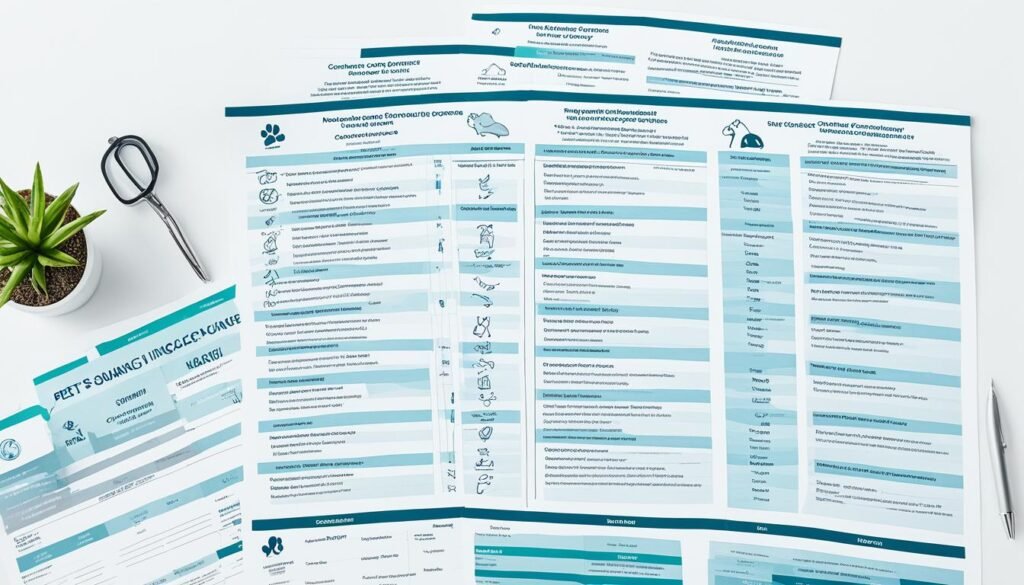For many pet owners, the decision to invest in Pet Insurance Worth It can be a complex one. While pet insurance can provide valuable financial protection in the event of unexpected veterinary expenses, it’s important to carefully evaluate the potential benefits and drawbacks to determine if it’s the right choice for your pet and your budget. In this article, we’ll explore the ins and outs of pet insurance, helping you make an informed decision on whether it’s worth the investment.
Pet insurance is a type of insurance coverage that helps pet owners manage the costs of unexpected veterinary care for their pets, such as accidents, illnesses, and routine check-ups. The main purpose of pet insurance is to provide financial protection for pet owners in the event their pet requires costly medical treatment. By paying a monthly premium, pet owners can receive reimbursement for a portion of their veterinary expenses, depending on the specific coverage and plan details.
Key Takeaways
- Pet insurance can help cover the costs of unexpected veterinary care, such as accidents, illnesses, and routine check-ups.
- The cost of pet insurance can vary depending on factors like the type of pet, breed, size, and age.
- There are different types of pet insurance plans, including accident-only, accident and illness, and wellness coverage.
- Pre-existing conditions may be excluded from pet insurance coverage, so it’s important to understand the policy details.
- Comparing pet insurance companies and their offerings can help you find the best coverage for your pet’s needs and your budget.
Understanding Pet Insurance
Pet insurance is a specialized type of coverage that helps pet owners manage the costs of unexpected veterinary care for their beloved companions. This insurance policy provides financial protection against a variety of accidents, illnesses, and even routine check-ups that can result in significant veterinary expenses.
What is Pet Insurance?
At its core, pet insurance is designed to reimburse pet owners for a portion of their veterinary expenses when their pet requires medical attention. By paying a monthly premium, pet owners can access a range of coverage options and plan details that cater to their specific needs and the needs of their insured pets in the U.S.
Why Consider Pet Insurance?
The primary benefit of pet insurance is the financial security it provides. Unexpected veterinary expenses can quickly add up, with the average cost of treating a pet’s accident or illness often reaching thousands of dollars. Pet insurance helps pet owners mitigate these costs, allowing them to focus on providing the best possible veterinary care for their furry companions without the added burden of financial stress.
Furthermore, pet insurance can offer peace of mind, knowing that your pet is protected by a comprehensive policy from providers like Pets Best, North American Pet Health Insurance, and the American Pet Health Insurance Association. This can be especially valuable in times of unexpected medical needs, ensuring that your pet receives the care they require without significant out-of-pocket expenses.
Pet Insurance Worth It
Determining whether pet insurance is worth it for your pet requires carefully weighing the potential benefits and drawbacks. There are several factors to consider:
First, think about your pet’s health needs and the likelihood of unexpected veterinary expenses. If your pet is generally healthy, pet insurance may not provide as much value. However, if your pet is prone to accidents, illnesses, or chronic conditions, pet insurance could help cover the cost of pet insurance and provide peace of mind.
The cost of pet insurance is another important consideration. Pet insurance premiums can vary widely depending on the type of pet, breed, age, and level of coverage. Younger, healthier pets typically have lower premiums, while older pets and larger dogs may face higher monthly premiums as they increase as your pet ages.
It’s also crucial to understand the coverage and limitations of different pet insurance plans. Accident-only policies tend to be more affordable, but they won’t cover illnesses or wellness care. Accident and illness coverage provides more comprehensive protection, but may come with higher deductibles, co-pays, and reimbursement rates.
Ultimately, pet insurance may be worth it if you want to ensure your pet receives the best possible veterinary care without worrying about the vet bill. By considering pet insurance, you can find a plan that fits your pet’s needs and your budget, providing valuable financial protection and peace of mind.

Factors Influencing Pet Insurance Costs
The cost of pet insurance can vary significantly depending on several factors, including the type of pet, the breed and size of the pet, and the age of the pet. Understanding these key variables can help pet owners make informed decisions when shopping for the best pet insurance coverage for their furry companions.
Type of Pet
The type of pet you have can greatly impact the cost of pet insurance. Generally, insurance for dogs tends to be more expensive than for cats, as dogs often require more veterinary care and have higher medical expenses. Additionally, larger dog breeds may have higher premiums and monthly premiums compared to smaller breeds.
Breed and Size
The breed and size of your pet can also influence the cost of pet insurance. Certain breeds may be predisposed to specific health conditions or have a higher risk of injuries, leading to higher premiums. For example, larger dogs often have higher monthly premiums due to their increased likelihood of developing orthopedic issues or other medical conditions.
Age of Your Pet
The age of your pet is another important factor that can affect the cost of pet insurance. As pets age, their risk of developing health issues and the need for more frequent veterinary care increases. Consequently, pet insurance premiums tend to increase as your pet ages. This is an important consideration for pet owners, as pet insurance varies greatly depending on the age of the insured pets in the U.S.

Types of Pet Insurance Plans
When exploring pet insurance, it’s crucial to understand the different types of coverage available. Pet insurance plans can be categorized into three main types: accident-only coverage, accident and illness coverage, and wellness coverage.
Accident-Only Coverage
Accident-only pet insurance provides coverage for medical expenses related to unexpected injuries or accidents, such as broken bones, cuts, or other accidental trauma. This type of plan typically has lower premiums but offers more limited coverage compared to accident and illness plans.
Accident and Illness Coverage
Accident and illness pet insurance offers the most comprehensive coverage, protecting your pet from both unexpected accidents and illnesses, including conditions like cancer, allergies, or infections. This plan typically has higher monthly premiums but provides greater financial protection for your pet’s overall health.
Wellness Coverage
Wellness coverage is often offered as an add-on to accident and illness plans or as a standalone plan. This type of coverage helps offset the costs of routine veterinary care, such as annual check-ups, vaccinations, and preventive treatments. While wellness coverage can increase the overall premium, it can help pet owners budget for their pet’s regular healthcare needs.
| Type of Pet Insurance Plan | Coverage | Typical Monthly Premium | Deductible | Co-Pay | Reimbursement Rate | Coverage Limits | Exclusions |
|---|---|---|---|---|---|---|---|
| Accident-Only | Covers unexpected injuries or accidents | Lower | Varies | Varies | Varies | Varies | Excludes illnesses |
| Accident and Illness | Covers unexpected injuries, accidents, and illnesses | Higher | Varies | Varies | Varies | Varies | Excludes pre-existing conditions |
| Wellness Coverage | Covers routine preventive care, such as checkups, vaccinations, and dental cleanings | Varies | No deductible | No co-pay | 100% reimbursement up to coverage limits | Annual or per-incident limits | Excludes pre-existing conditions and non-routine care |

Pre-existing Conditions and Pet Insurance
One important consideration when evaluating pet insurance is the treatment of pre-existing conditions. Pre-existing conditions are any injuries, illnesses, or other medical issues that a pet had prior to the start of the insurance policy. Many pet insurance providers will exclude coverage for pre-existing conditions, or they may only cover them after a certain waiting period.
It’s crucial to understand the exclusions in a pet insurance plan, as pre-existing conditions can significantly impact the coverage provided. Some pet insurance companies, such as Pets Best and North American Pet Health Insurance Association, may be more flexible in their approach to pre-existing conditions, offering coverage or partial coverage depending on the specific circumstances.
If your pet has a known pre-existing condition, it’s essential to research pet insurance options thoroughly and compare the coverage offered by different providers. This can help ensure that your pet receives the necessary medical care and that the insurance helps cover the costs, even as your pet gets injured or gets older during the life of your pet. Choosing the one pet insurance plan that best suits your needs can provide valuable financial protection for your furry companion.

Deductibles, Co-pays, and Reimbursement Rates
When evaluating pet insurance plans, it’s important to understand the key terms and features that can impact the overall value of the coverage, including deductibles, co-pays, and reimbursement rates. These factors can significantly influence the amount you’ll pay out-of-pocket for your pet’s medical expenses and the level of financial protection you’ll receive from your Pets Best insurance policy.
Also Read : Shielding Your Business: Essential Contractor Insurance Solutions
Deductibles
The deductible is the amount you must pay out-of-pocket before your pet insurance plan begins to reimburse you for covered veterinary expenses. Deductibles can range from $0 to $1,000 or more, depending on the North American Pet Health Insurance Association plan you choose. Generally, plans with higher deductibles have lower monthly premiums, but you’ll be responsible for more of the initial costs when your pet needs medical care.
Co-pays
In addition to the deductible, many pet insurance plans also require you to pay a co-pay, which is a percentage of the total veterinary bill that you’re responsible for after the deductible has been met. Co-pays can range from 10% to 30% or more, and the lower the co-pay, the higher the monthly premium will be. Understanding the co-pay structure is crucial when selecting the right level of coverage for your pet’s needs and your budget.
Reimbursement Rates
The reimbursement rate is the percentage of the veterinary bill that your pet insurance plan will cover after you’ve met the deductible and co-pay requirements. Reimbursement rates can vary widely, from 60% to 90% or more, depending on the American Pet Health Insurance Association plan you choose. Higher reimbursement rates mean you’ll be responsible for a smaller portion of the total cost, but they also come with higher monthly premiums.
By understanding these key terms and features, you can better evaluate the level of coverage that best suits your pet’s needs and your financial situation, whether you have an accident and illness policy, an accident-only plan, or a wellness coverage add-on.

| Feature | Description | Impact on Cost |
|---|---|---|
| Deductible | The amount you pay out-of-pocket before insurance coverage begins | Higher deductibles = lower monthly premiums, but higher out-of-pocket costs |
| Co-pay | The percentage of the vet bill you pay after meeting the deductible | Higher co-pays = lower monthly premiums, but higher out-of-pocket costs |
| Reimbursement Rate | The percentage of the vet bill covered by the insurance plan | Higher reimbursement rates = higher monthly premiums, but lower out-of-pocket costs |
Comparing Pet Insurance Companies
When shopping for pet insurance, it’s important to compare different providers and their offerings to find the best coverage for your pet. Some key factors to consider when comparing pet insurance companies include:
Coverage Limits
Examine the coverage limits of each pet insurance plan. This will determine the maximum amount the insurance company will pay out for accident and illness claims over the lifetime of your pet. Higher limits typically mean higher premiums, but can provide more comprehensive coverage if your pet has significant medical needs.
Exclusions
Understand the exclusions in each pet insurance policy. Some common exclusions include pre-existing conditions, preventative care, and certain hereditary or congenital conditions. Reviewing the exclusions can help you determine if the plan meets your pet’s specific needs.
Customer Service
Evaluate the quality of customer service provided by the pet insurance company. This includes factors like the ease of filing claims, the responsiveness of the company, and the overall satisfaction of policyholders. Pets Best, North American Pet Health Insurance, and the American Pet Health Insurance Association are resources that can provide insights into customer service and industry reputation.
| Pet Insurance Company | Coverage Limits | Exclusions | Customer Service |
|---|---|---|---|
| Pets Best | Up to $20,000 per year | Pre-existing conditions, preventative care, certain hereditary or congenital conditions | Highly rated for ease of claims and responsiveness |
| Healthy Paws | Unlimited lifetime coverage | Pre-existing conditions, preventative care, certain behavioral issues | Generally positive reviews for customer service and claims processing |
| Trupanion | No per-incident or annual limits | Pre-existing conditions, preventative care, certain dental conditions | Known for efficient claims handling and personalized support |

Alternatives to Pet Insurance
While pet insurance can provide valuable financial protection for pet owners, it may not be the right choice for everyone. There are several alternatives to consider, including pet savings accounts and care credit programs.
Pet Savings Accounts
One alternative to pet insurance is a dedicated pet savings account. By setting aside a monthly or annual contribution to a separate savings account, pet owners can build up a fund to cover unexpected veterinary expenses. This approach allows for more control over the funds and can be a cost-effective solution for those with healthy pets who may not need the comprehensive coverage of a pet insurance plan.
Care Credit
Another alternative is Care Credit, a healthcare financing option that can be used for veterinary expenses. Care Credit offers flexible payment plans and can be a useful resource for managing the cost of unexpected medical treatments or procedures for pets. However, it’s important to carefully review the terms and conditions to understand the interest rates and repayment requirements.
Ultimately, the decision to pursue pet insurance or explore alternative options should be based on a thorough evaluation of your pet’s needs, your financial situation, and your personal preferences. By weighing the pros and cons, you can make an informed decision that provides the best care and protection for your beloved companion.
FAQs
What is pet insurance?
Pet insurance is a type of insurance coverage that helps pet owners manage the costs of unexpected veterinary care for their pets, such as accidents, illnesses, and routine check-ups. The main purpose of pet insurance is to provide financial protection for pet owners in the event their pet requires costly medical treatment.
Why should I consider pet insurance?
Pet insurance can provide pet owners with financial protection in the event their pet requires unexpected veterinary care, which can be costly. By paying a monthly premium, pet owners can receive reimbursement for a portion of their veterinary expenses, depending on the specific coverage and plan details.
Is pet insurance worth it?
Determining whether pet insurance is worth it for your pet requires carefully weighing the potential benefits and drawbacks. Factors to consider include the cost of the monthly premium, the coverage provided, the age and health of your pet, and the likelihood of unexpected veterinary expenses.
What factors influence the cost of pet insurance?
The cost of pet insurance can vary significantly depending on several factors, including the type of pet, the breed and size of the pet, and the age of the pet. Generally, larger dogs and older pets tend to have higher insurance premiums.
What are the different types of pet insurance plans?
Pet insurance plans can be categorized into three main types: accident-only coverage, accident and illness coverage, and wellness coverage. Accident-only plans cover unexpected injuries, while accident and illness plans also cover unexpected illnesses. Wellness coverage can help with the cost of routine veterinary care, such as check-ups and vaccinations.
How are pre-existing conditions handled with pet insurance?
One important consideration when evaluating pet insurance is the treatment of pre-existing conditions. Pre-existing conditions are any injuries, illnesses, or other medical issues that a pet had prior to the start of the insurance policy. Most pet insurance providers will not cover pre-existing conditions, but some may offer coverage for certain conditions after a waiting period.
What are deductibles, co-pays, and reimbursement rates in pet insurance?
Deductibles, co-pays, and reimbursement rates are key terms to understand when evaluating pet insurance plans. The deductible is the amount you must pay out of pocket before the insurance coverage begins. Co-pays are the percentage of the veterinary bill you must pay after the deductible is met. The reimbursement rate is the percentage of the veterinary bill that the insurance company will pay.
How do I compare pet insurance companies?
When shopping for pet insurance, it’s important to compare different providers and their offerings to find the best coverage for your pet. Some key factors to consider include coverage limits, exclusions, and customer service. It’s also important to review the details of the plan, such as the deductible, co-pay, and reimbursement rate.
What are some alternatives to pet insurance?
Alternatives to pet insurance include pet savings accounts and CareCredit. Pet savings accounts allow you to set aside money for future veterinary expenses, while CareCredit is a credit card specifically for healthcare expenses, including veterinary care.




